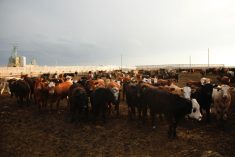Compared to mid-December, western Canadian yearlings traded $3-$5 lower; mid-weight calves are down $4-$6 while calves under 550 lbs. remained firm. Buyers exhibited a defensive tone on heavier yearlings and discounts were more severe on fleshier cattle last week.
There is absolutely no risk appetite for 850-plus-lb. cattle at this time of year. Demand for 600- to 800-lb. calves surfaced but buyers had a sharp pencil. Feeder cattle futures are down about $5 from last month and basis levels feel sluggish. Weather conditions were quite variable last week. Vaccinated calves held a minimal premium. Calves coming straight off their mothers were at a slight discount to weaned or semi-weaned cattle. Many auction barns are still in holiday mode and buyers are expecting the market to soften over the next couple of weeks as more cattle come onstream. Order buyers were searching for business last week, with buying interest surfacing $5-$8 below current levels. Buyers are factoring in a risk discount due to stronger feed grains.
Read Also

Alberta crop conditions improve: report
Varied precipitation and warm temperatures were generally beneficial for crop development across Alberta during the week ended July 8, according to the latest provincial crop report released July 11.
In central Alberta, larger-frame Simmental-based steers with medium to heavier flesh averaging 920 lbs. were quoted at $169; however, yearlings with lower flesh were readily trading $2-$4 above this level. Mixed medium-frame heifers with light flesh averaging just under 1,000 lbs. were valued at $153. In southern Alberta, medium-frame Hereford-blended steers with heavier butter weighing 840 lbs. were quoted at $180 and similar-quality mixed heifers weighing 905 lbs. were reported at $154.
In southern Alberta, larger-frame semi-weaned tan steers averaging 655 lbs. were valued at $193 and similar-quality 600-pounders were quoted at $195. These cattle were on the fleshier side. Angus-blended semi-weaned heifers averaging 655 lbs. were quoted at $175 in the same region. In central Alberta, mixed steers on a full health program coming fresh off their mothers weighing 550 lbs. were quoted at $220. We’re starting to see demand surface for grassers, which has kept the feather-light bawlers well supported. In central Alberta, Charolais-based steers weighing just over 400 lbs. were quoted at $160. Next week, the first sales of the year are expected at many locations in Manitoba and Saskatchewan.
Compared to Dec. 15, the March corn futures are up nearly 70 cents per bushel. At the same time, we’ve seen a $15-$20 per tonne rally in the feed barley market. Feedlots that booked their feed grains early have a definite advantage; however, there are many operations caught off guard. Securing feed grains is a major risk this year; major feedlots are now holding 15-20 days of usage instead of four to five days. “Just in time” has changed to “just in case.”
— Jerry Klassen manages the Canadian office of Swiss-based grain trader GAP SA Grains and Produits Ltd. and is president and founder of Resilient Capital, specializing in proprietary commodity futures trading and market analysis. Jerry consults with feedlots on risk management and writes a weekly cattle market commentary. He can be reached at 204-504-8339 or via his website at ResilCapital.com.




















